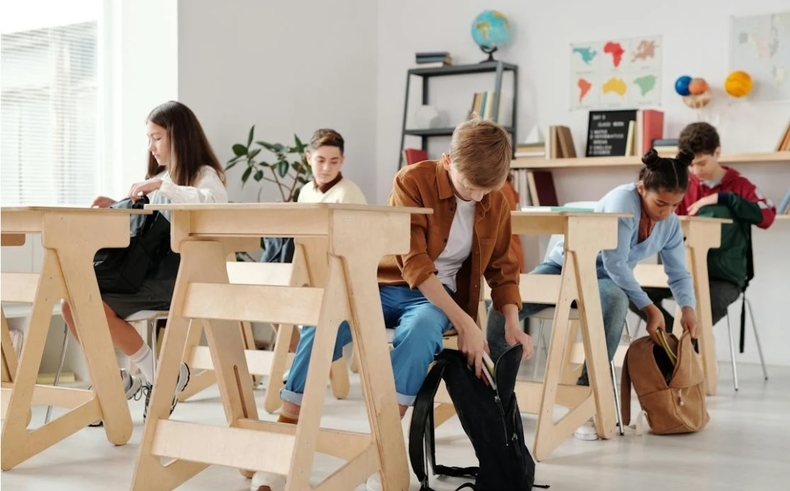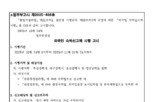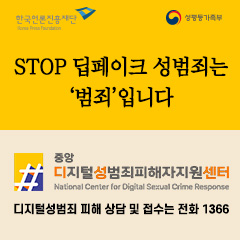
Low birth rate and increasing multicultural and immigrant population: 200,000 multicultural students expected by 2025
Comprehensive support for academic enhancement, emotional, and career counseling
Due to the phenomenon of a declining birth rate, the number of students in elementary, middle, and high schools has steadily decreased. However, the number of multicultural students continues to rise, and it is projected to reach 200,000 by 2025. This has led to the analysis that there is a need for an 'in-country perspective' education policy, considering the higher proportion of students born in Korea from foreign families.
According to the educational statistics from 2023, published on Korea Educational Development Institute (KEDI) Brief by Kang Sung-guk, a senior researcher at the KEDI, the number of multicultural students residing in South Korea due to international marriages, parents' immigration, and employment exceeded 180,000 last year, accounting for approximately 3.5% of the total student population.
Multicultural students can be broadly categorized into those from international marriage families and those from foreign families. Among the international marriage families, multicultural students born in Korea accounted for 71.7%, totaling 129,910 students, while students from foreign families were 22.3%, totaling 43,720 students. Additionally, students from international marriage families who entered the country mid-term were reported as 6.0%, totaling 18,960 students.
Multicultural students from various countries include 58,136 from Vietnam (32.1%), 44,587 from China (excluding Korean descent), and 16,568 from the Philippines. The percentage of multicultural students in elementary schools increased by 0.2% compared to 2022, reaching 4.4%, while middle schools and high schools increased by 0.4% each to 3.3% and 1.7%, respectively.
In Seoul, there are nine elementary schools where the percentage of multicultural students exceeds 40%. According to the Seoul Metropolitan Office of Education on the 7th, Yeongrim Elementary School in Yeongdeungpo-gu (70.93%) and Daedong Elementary School (70.88%) have a multicultural student ratio exceeding 70%.
As the number of new students in Seoul elementary schools recorded the first-ever figure below 60,000, reducing the overall student population, the proportion of multicultural students has relatively increased. In the Gyeonggi region, the number of multicultural students surged by over 10% last year, approaching 50,000. The students' countries of origin also increased to 22, and schools with multicultural students accounting for 30% or more increased by 20% to 57 within a year.
To adapt to the increasing trend of multicultural and immigrant students amid the low birth rate, the government and the office of education are making changes. The Ministry of Gender Equality and Family announced on the 16th that it will provide tailored support for the healthy growth of multicultural children and teenagers from elementary school to high school, including customized learning and career guidance.
The Ministry will expand the operation centers supporting pre-elementary and elementary school basic education for multicultural family children from 138 to 168. Youth emotional and career counseling centers operating programs for academic concerns, interpersonal relationships, and self-directed career planning will also be expanded from 113 to 143.
The Ministry will also strengthen support for bilingual learning to facilitate the students to use their parents’ native language and Korean together. The participation age range will be expanded from under 12 to under 18. Additionally, the Ministry is introducing a new initiative to support educational activity expenses for low-income multicultural children, allowing them to use funds for book purchases and access to study rooms.
The Seoul Metropolitan Office of Education added guidelines for dealing with multicultural students to the materials distributed to national, public, and private elementary schools. Also, all teachers will be required to take a mandatory 15-hour multicultural education training within three years.
The Gyeonggido Office of Education collaborated with local governments and established Korea Language Sharing Schools in Dongducheon for the first time in the country. This initiative aims to provide concentrated education for pre-school foreign families and students entering the country midway, promoting basic academic skills and helping them adapt to school. The office of education plans to expand the number of shared schools to 12 to respond to multicultural education and foster global talents among domestic students through diversity education.
(한국어 번역)
한국다문화뉴스 = 심민정 기자ㅣ저출생 현상과 늘어나는 다문화·이주민, 2025년 다문화학생 20만 명
기초학력 증진, 정서·진로 상담 등 다각도 지원
저출생 현상으로 초·중·고교생 수는 꾸준히 감소하고 있는 반면, 다문화 학생 수가 계속 증가하여 2025년에는 20만 명에 이를 것으로 보인다. 이에 국내에서 출생한 학생의 비율이 높아 외국인 가정과 다른 ‘내국인 관점’의 교육정책이 필요하다는 분석이 나왔다.
31일 교육계에 따르면, 한국교육개발연구원(KEDI) 강성국 선임연구위원은 KEDI브리프에 게재된 ‘2023 교육기본통계로 살펴본 한국 교육 현황’ 자료를 통해 이같이 전했다.
지난해 국제결혼이나 부모의 이민, 취업 등으로 국내에 거주하는 다문화 학생이 18만 명을 넘어, 전체의 3.5% 수준까지 올라왔다.
다문화 학생은 크게 국제결혼가정과 외국인 가정으로 나뉜다. 국제결혼가정 중 국내 출생 다문화 학생은 12만 9천910명으로 전체 학생 대비 71.7%를 차지했으며, 외국인 가정은 4만 372명으로 22.3%, 국제결혼가정의 중도입국 학생은 1만 896명 6.0%로 조사됐다.
부모 출신국별 다문화 학생은 베트남계가 5만 8천136명(32.1%), 중국(한국계 제외) 4만 4천587명(24.6%), 필리핀 1만 6천568명(9.1%)로 많았다. 학급별 다문화 학생 비율은 초등학교가 4.4%로 2022년 대비 0.2% 상승했으며, 중학교는 3.3%, 고등학교는 1.7%로 각각 전년 대비 0.4%포인트씩 상승했다.
서울에서 다문화 학생 비율이 40% 넘는 초등학교도 9곳에 달한다. 7일 서울시교육청에 따르면, 서울 영등포구 영림초등학교(70.93%), 대동초등학교(70.88%)는 다문화 학생 비율이 70%를 넘었다.
서울 초등학교 신입생이 사상 첫 5만 명대를 기록하며 전체 학생 수가 낮아지고 있어 다문화 학생들이 차지하는 비율은 상대적으로 더 커졌다.
경기 지역도 지난해 다문화 학생이 10% 넘게 급증하여 5만 명에 육박한다. 학생들의 출신 국가도 22곳으로 늘었으며, 한 학교에 30% 이상이 다문화 학생인 다문화 밀집학교는 1년 사이 20% 늘어 57곳이다.
저출생 속에서 늘어나는 다문화·이주민 증가의 흐름에 정부와 교육 당국도 변화하고 있다. 여성가족부는 16일 다문화 아동·청소년의 건강한 성장을 위해 초등학교에서 중고등학교까지 성장단계별로 학습과 진로 등을 맞춤형으로 지원한다고 밝혔다.
여가부는 다문화가족 자녀의 취학 전·초등기 기초학습을 지원하는 운영센터를 138개소에서 168개소로 확대한다. 학업, 교우관계 등 고민 상담과 자기 주도적 진로 설계 프로그램을 운영하는 청소년기 정서·진로상담 운영센터도 기존 113개소에서 143개소로 확대한다.
부모의 모국어와 한국어를 같이 사용할 수 있도록 이중언어 학습 지원도 강화하며, 참여 자녀 연력을 12세 이하에서 18세까지로 확대한다. 또 저소득 다문화 자녀를 대상으로 도서 구매나 독서실 이용에 사용할 수 있는 교육활동비 지원 사업도 새로 추진한다.
서울시교육청은 국·공·사립 초등학교에 배포하는 도움 자료에 다문화 학생을 대하는 법을 추가했다. 또 모든 교원을 대상으로 3년 이내 15시간 이상 다문화교육 직무 연수를 의무화했다.
경기도교육청도 지방자치단체와 손을 잡고 전국에서 처음으로 동두천에 한국어공유학교를 열었다. 취학 전 외국인 가정이나 중도입국 학생들에게 집중 교육을 제공하여 기초학력 증진과 학교 적응을 돕기 위해서다.
도교육청은 공유학교를 12개까지 확대해 다문화 교육에 대응하고, 국내 학생들에겐 다양성 교육을 통해 글로벌 인재를 양성하겠다는 계획이다.





















